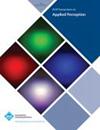结合振动和静电摩擦刺激的触觉纹理显示:对现实主义的实质性影响和对行为反应的适度影响
IF 2.1
4区 计算机科学
Q3 COMPUTER SCIENCE, SOFTWARE ENGINEERING
引用次数: 2
摘要
人们对触摸板的触觉反馈功能的需求越来越大。我们研究了同时使用振动触觉和静电摩擦刺激是否可以改善虚拟粗糙度纹理质量。这种结合使用有望改善纹理刺激的感知质量,因为振动触觉和静电摩擦刺激具有互补的特性。我们以前的研究证实,这些联合刺激提高了简单光栅粗糙度的真实感。在这项研究中,我们使用由一个或两个空间波分量组成的简单和复杂正弦表面剖面进行了实验。采用了三种不同的评价标准。第一个标准涉及虚拟粗糙度纹理的主观真实感,即与实际粗糙度纹理的相似性。参与者比较了以下三种刺激条件:只有振动触觉刺激、只有静电摩擦刺激和它们的联合刺激。共同的刺激产生了最大的现实主义。第二个准则涉及五种不同粗糙度纹理在三种刺激条件下的粗糙度纹理识别。在联合刺激条件下,识别准确率最高;然而,性能差异是微乎其微的。第三个准则涉及光栅尺度空间波长的识别阈值。三种情况下的结果没有显著差异。本研究结果将有助于改善触控面板型表面触觉显示器的虚拟纹理质量。本文章由计算机程序翻译,如有差异,请以英文原文为准。
Tactile Texture Display Combining Vibrotactile and Electrostatic-friction Stimuli: Substantial Effects on Realism and Moderate Effects on Behavioral Responses
There is increasing demand for tactile feedback functions for touch panels. We investigated whether virtual roughness texture quality can be improved through simultaneous use of vibrotactile and electrostatic-friction stimuli. This conjunctive use is expected to improve the perceptual quality of texture stimuli, because vibrotactile and electrostatic-friction stimuli have complementary characteristics. Our previous studies confirmed that these conjunct stimuli yield enhanced realism for simple grating roughness. In this study, we conducted experiments using simple and complex sinusoidal surface profiles consisting of one or two spatial wave components. Three different evaluation criteria were employed. The first criterion concerned the subjective realism, i.e., similarity with actual roughness textures, of virtual roughness textures. Participants compared the following three stimulus conditions: vibrotactile stimuli only, electrostatic-friction stimuli only, and their conjunct stimuli. The conjunct stimuli yielded the greatest realism. The second criterion concerned roughness texture identification under each of the three stimulus conditions for five different roughness textures. The highest identification accuracy rate was achieved under the conjunct stimulus condition; however, the performance difference was marginal. The third criterion concerned the discrimination threshold of the grating-scale spatial wavelength. There were no marked differences among the results for the three conditions. The findings of this study will improve virtual texture quality for touch-panel-type surface tactile displays.
求助全文
通过发布文献求助,成功后即可免费获取论文全文。
去求助
来源期刊

ACM Transactions on Applied Perception
工程技术-计算机:软件工程
CiteScore
3.70
自引率
0.00%
发文量
22
审稿时长
12 months
期刊介绍:
ACM Transactions on Applied Perception (TAP) aims to strengthen the synergy between computer science and psychology/perception by publishing top quality papers that help to unify research in these fields.
The journal publishes inter-disciplinary research of significant and lasting value in any topic area that spans both Computer Science and Perceptual Psychology. All papers must incorporate both perceptual and computer science components.
 求助内容:
求助内容: 应助结果提醒方式:
应助结果提醒方式:


